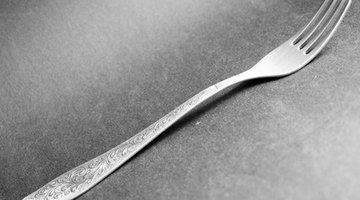Silverware Vs. Silverplate
Table of Contents
The term silverware applies to any object made of or plated with silver. The critical distinction is between items made of solid sterling silver and items merely plated with sterling silver. According to SilverHeaven.com, sterling silver is a metal alloy comprised of 92.5 percent silver and 7.

5 percent copper, which is added to the silver to improve durability. The most common silverware utensils are flatware (knives, forks, spoons), serving trays and beverage servers like coffeepots.
What is Silverplate?
Silverplate is an item made of a base metal like copper, brass or stainless steel that has been electroplated with sterling silver. The plating is thinner than a human hair. Silver electroplate came into use in the late 19th century, allowing manufacturers to broaden their market by offering low-priced silverware.
Sterling Items
By contrast, silverware made of sterling silver is made entirely of that precious metal, except perhaps for handles, finials or decoration made of something non-metallic such as ivory or wood. Items made of sterling silver are marked. Common markings are the word “sterling,” or the number 925 or the fraction 925/1000 stamped into the metal. No matter what happens, sterling silver items will always retain the intrinsic value of their precious metal. Silver plate, by contrast, has no intrinsic value and any collector value quickly disappears if the silver plating wears through to the base metal beneath.
Tarnish and Corrosion
Sterling and silverplate are both subject to tarnishing from sulfur compounds in the air and from the salts and oils of our skin. Silverware stored in damp conditions and not cleaned properly may develop crusty green deposits from corrosion. The best way to preserve your silverware’s appearance is prevention of tarnish and corrosion, according to the American Society of Silversmiths.
Care of Silverware
Silverware after use should be washed by hand with a non-lemon-scented, phosphate-free dish detergent and dried immediately with a soft dish towel. Never wash silverware in a dishwasher, according to the Society of Silversmiths, because the high heat and harsh detergents will leave a white deposit on the silver and may loosen the handles on hollow-handled knives and loosen any non-metal components. Salt and pepper are extremely corrosive to silver, so shakers should be emptied, washed and dried for storage.
Silverware Storage
Silverware should be stored in a chest, closed display case or polyethylene bag with commercial anti-tarnish strips and silica gel desiccant. You can also use a silver-impregnated anti-tarnish cloth to wrap your silverware for storage. Never use newspaper, rubber bands, plastic food wrap or cardboard boxes for silver storage as these contain acids and other chemicals that aggressively tarnish silver, according to the Society of Silversmiths.
Cleaning Silverware
Eventually, your silverware will tarnish. You can remove light tarnish with a commercial silver cleaner, while heavy tarnish may require a commercial silver polish or silver dip. Follow product directions. In general, you should polish in a straight line, not a circular motion, with a moist soft cloth or sponge. Use cotton swabs to get into crevices. Never use toothpaste as a silver polish; It is too abrasive. After polishing, rinse the silverware in warm water and dry it. Buff the pieces with a commercial rouge cloth to bring out the shine.
References
Writer Bio
Herb Kirchhoff has more than three decades of hands-on experience as an avid garden hobbyist and home handyman. Since retiring from the news business in 2008, Kirchhoff takes care of a 12-acre rural Michigan lakefront property and applies his experience to his vegetable and flower gardens and home repair and renovation projects.
Photo Credits
- silver dinner fork on a grey background image by Stepanov from Fotolia.com
- silver dinner fork on a grey background image by Stepanov from Fotolia.com
More Articles



